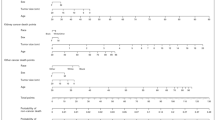Abstract
Objective
To study the impact of Charlson’s comorbidity index on overall survival following radical and partial nephrectomy performed for renal cell carcinoma (RCC).
Methods
Patients with primary RCC treated by tumor nephrectomy with at least 1 year of follow-up were included. The outcome parameters assessed were overall survival, impact of surgery on quality of life of patients using Karnofsky’s index and correlation of survival with respect to comorbid conditions, using Charlson’s index comorbidity score, grade and stage of disease.
Results
A total of 214 tumor nephrectomies were performed during study period, of which 157 (73%) fulfilling the criteria were included in the final analysis. The mean age at presentation was 57 ± 12 years. The mean Charlson’s index was 2.89 ± 2.22. Tumor stages were I–IV in 33, 30, 16 and 21%, respectively. The overall survival was 65% at a mean follow-up of 39 ± 5 months. The mean pre op Karnofsky’s index was 79.5 ± 7.13 and at follow-up it was 95.41 ± 10.65 (P < .001). The difference in functional status of patient (Karnofsky’s Index) for every stage including Stage-IV was statistically significant (P 0.01). Survival analysis showed a significant differences in overall survival according to stage (P 0.001), grade (P 0.001), size of tumor (P 0.001) and Charlson’s index (P = 0.05).
Conclusions
There was significant improvement in the quality of life, following tumor nephrectomy, even for Stage-IV cancers. Multivariate analysis indicated besides tumor stage, grade, and size of the tumor, Charlson’s index has a significant predictive value on overall survival.

Similar content being viewed by others
References
Jemal A, Siegel R, Ward E, Hao Y, Xu J, Murray T, Thun MJ (2008) Cancer statistics, 2008. CA Cancer J Clin 58(2):71–96
Aron M, Nguyen MM, Stein RJ, Gill IS (2008) Impact of gender in renal cell carcinoma: an analysis of the SEER database. Eur Urol 54(1):133–140
Hollingsworth JM, Miller DC, Daignault S, Hollenbeck BK (2007) Five-year survival after surgical treatment for kidney cancer: a population-based competing risk analysis. Cancer 109(9):1763–1768
Berger DA, Megwalu II, Vlahiotis A, Radwan MH, Serrano MF, Humphrey PA, Piccirillo JF, Kibel AS (2008) Impact of comorbidity on overall survival in patients surgically treated for renal cell carcinoma. Urology 72(2):359–363
Serrano MF, Humphrey PA, Piccirillo JF, Kibel AS (2003) TNM atlas-UICC. Guide illustre´ de la classification TNM/pTNM des tumeurs malignes. Springer, Berlin
Charlson ME, Pompei P, Ales KL, MacKenzie CR (1987) A new method of classifying prognostic comorbidity in longitudinal studies: development and validation. J Chronic Dis 40(5):373–383
Karnofsky DA, Burchenal JH (1949) The clinical evaluation of chemotherapeutic agents in cancer. In: MacLeod CM (ed) Evaluation of chemotherapeutic agents. Columbia Univ Press, New York, p 196
Woldrich JM, Mallin K, Ritchey J, Carroll PR, Kane CJ (2008) Sex differences in renal cell cancer presentation and survival: an analysis of the national cancer database, 1993–2004. J Urol 179(5):1709–1713
Donat SM, Salzhauer EW, Mitra N, Yanke BV, Snyder ME, Russo P (2006) Impact of body mass index on survival of patients with surgically treated renal cell carcinoma. J Urol 175(1):46–52
Kamat AM, Shock RP, Naya Y, Rosser CJ, Slaton JW, Pisters LL (2004) Prognostic value of body mass index in patients undergoing nephrectomy for localized renal tumors. Urology 63(1):46–50
Koppie TM, Serio AM, Vickers AJ, Vora K, Dalbagni G, Donat SM, Herr HW, Bochner BH (2008) Age-adjusted Charlson comorbidity score is associated with treatment decisions and clinical outcomes for patients undergoing radical cystectomy for bladder cancer. Cancer 112(11):2384–2392
Santos Arrontes D, Fernández Aceñero MJ, García González JI, Martín Muñoz M, Paniagua Andrés P (2008) Survival analysis of clear cell renal carcinoma according to the Charlson comorbidity index. J Urol 179(3):857–861
Gettman MT, Boelter CW, Cheville JC, Zincke H, Bryant SC, Blute ML (2003) Charlson co-morbidity index as a predictor of outcome after surgery for renal cell carcinoma with renal vein, vena cava or right atrium extension. J Urol 169(4):1282–1286
Author information
Authors and Affiliations
Corresponding author
Rights and permissions
About this article
Cite this article
Ather, M.H., Nazim, S.M. Impact of Charlson’s comorbidity index on overall survival following tumor nephrectomy for renal cell carcinoma. Int Urol Nephrol 42, 299–303 (2010). https://doi.org/10.1007/s11255-009-9636-8
Received:
Accepted:
Published:
Issue Date:
DOI: https://doi.org/10.1007/s11255-009-9636-8




